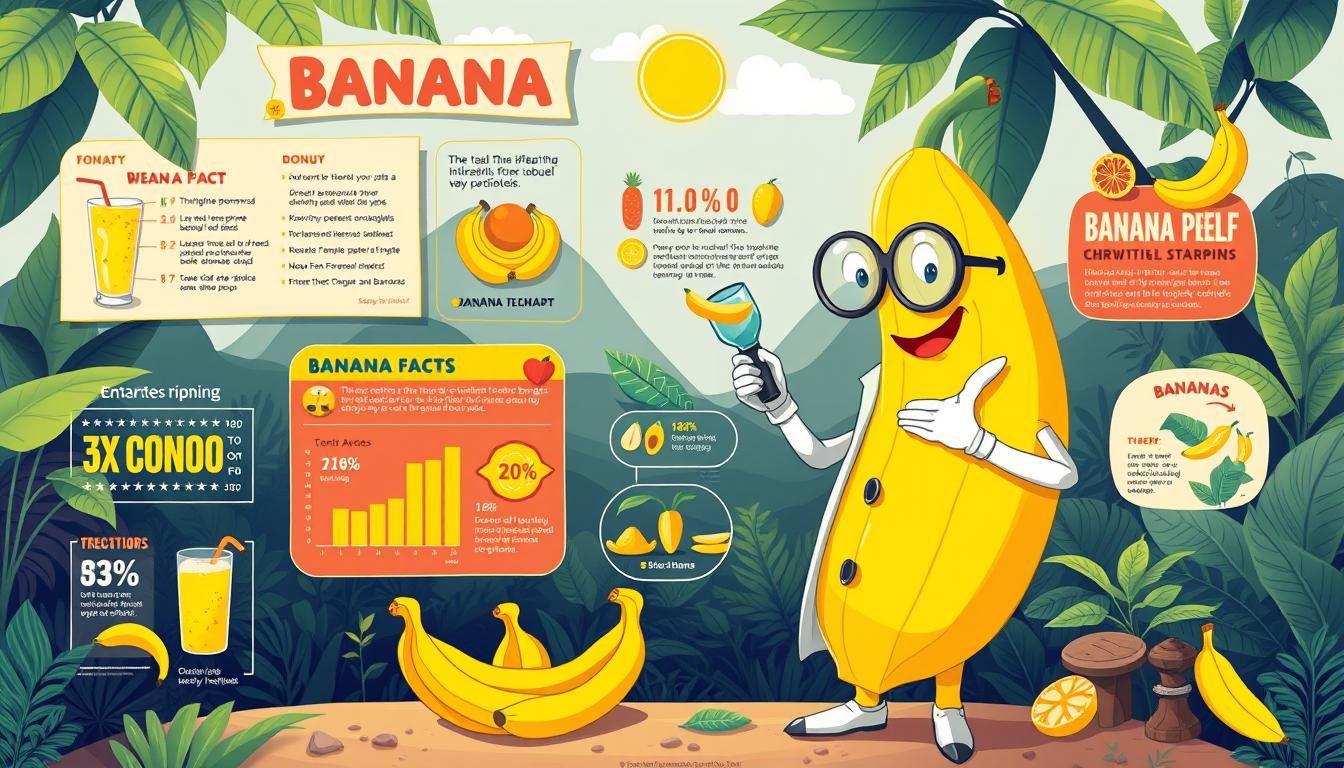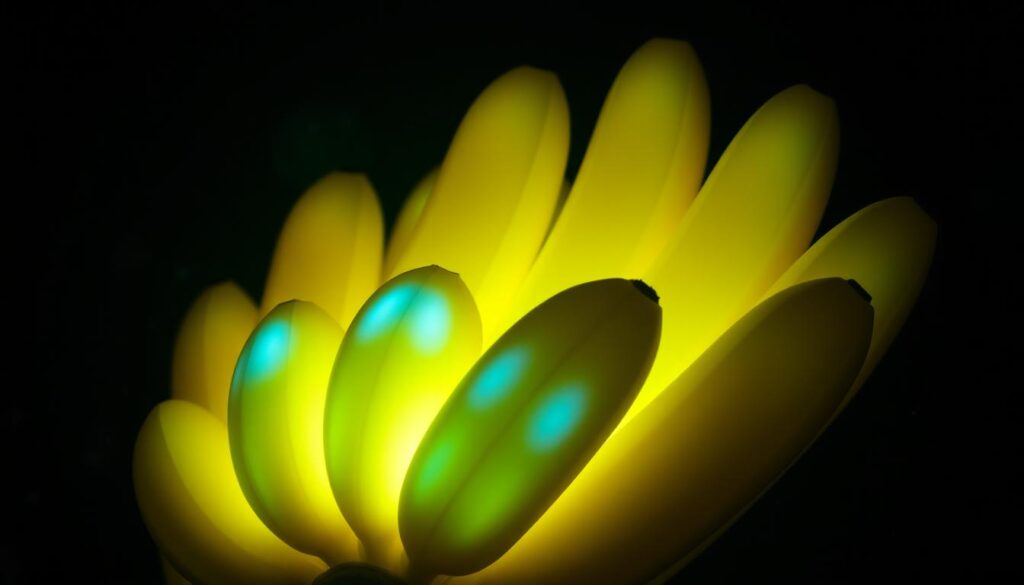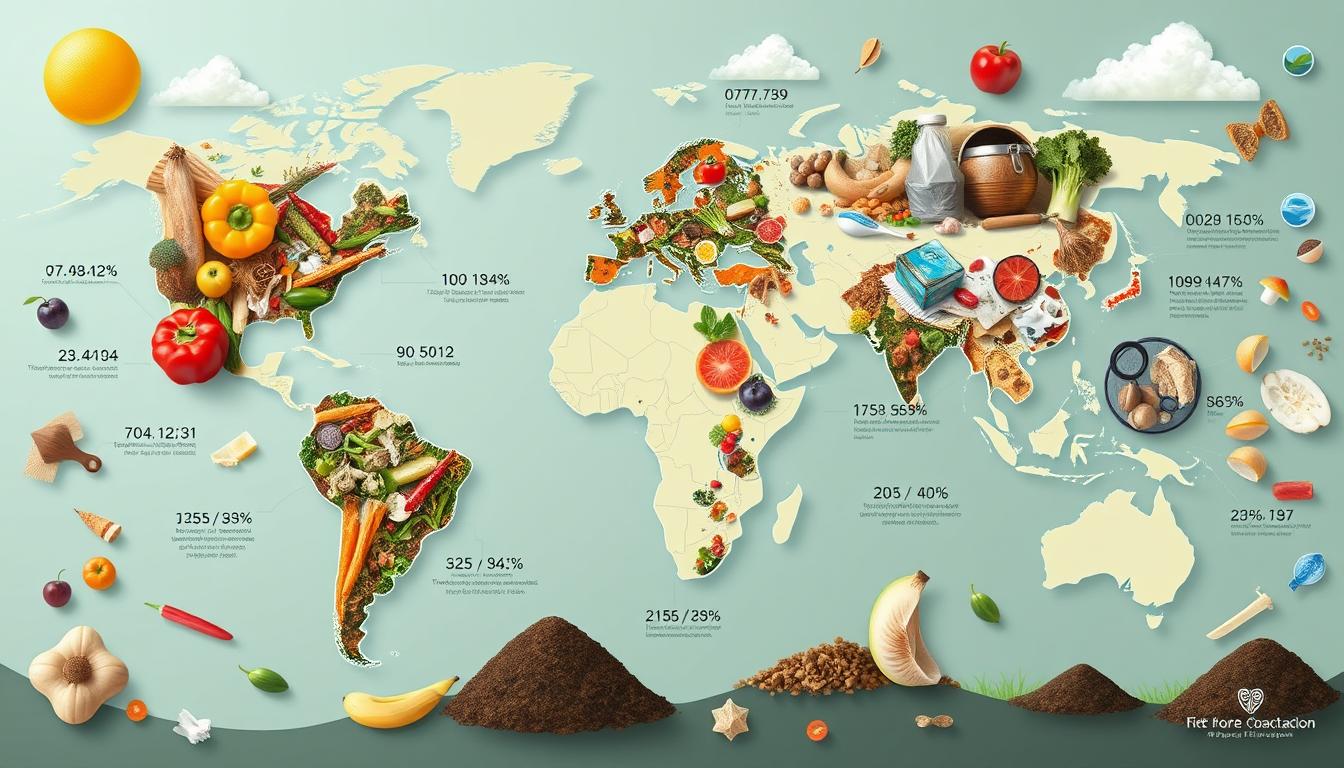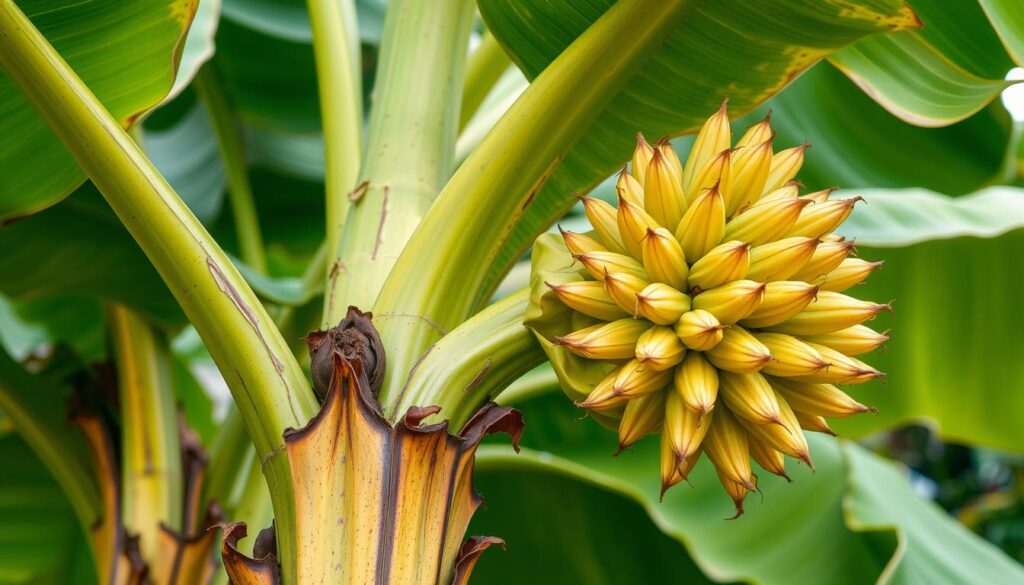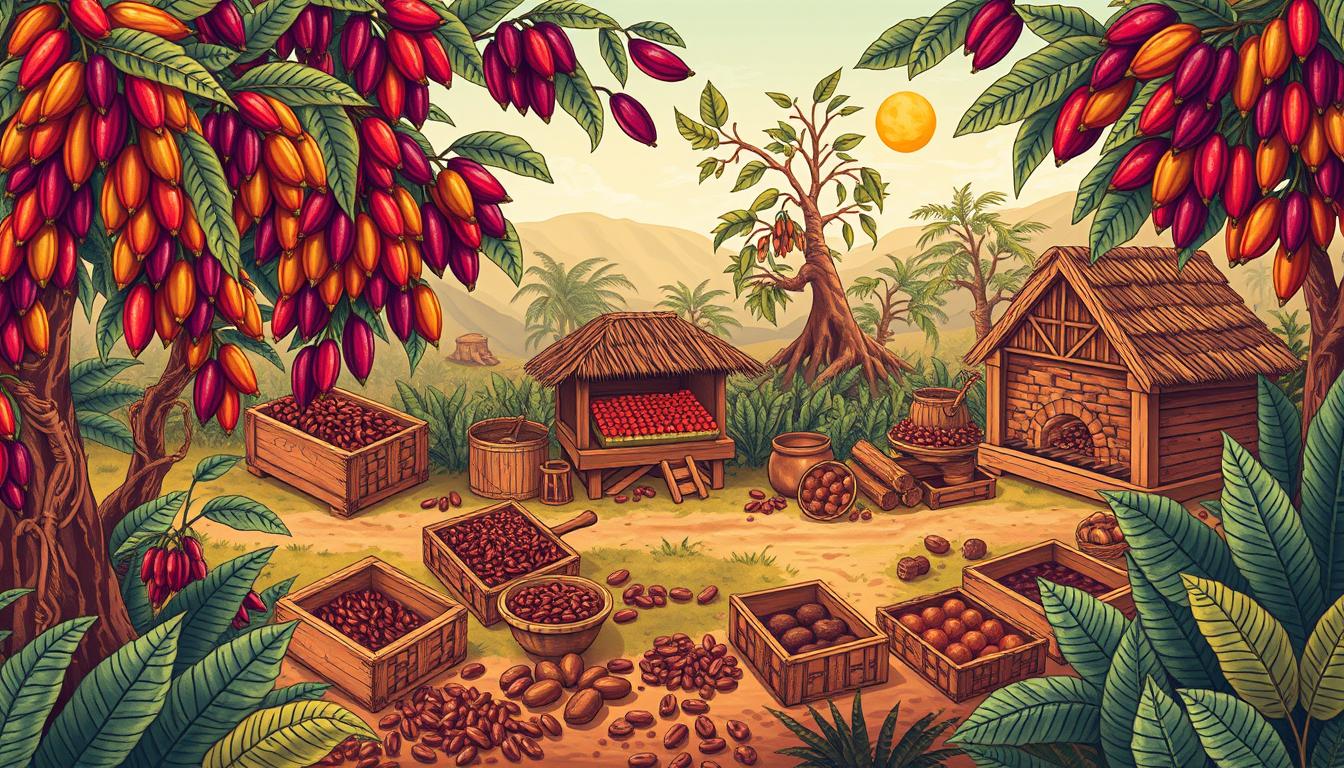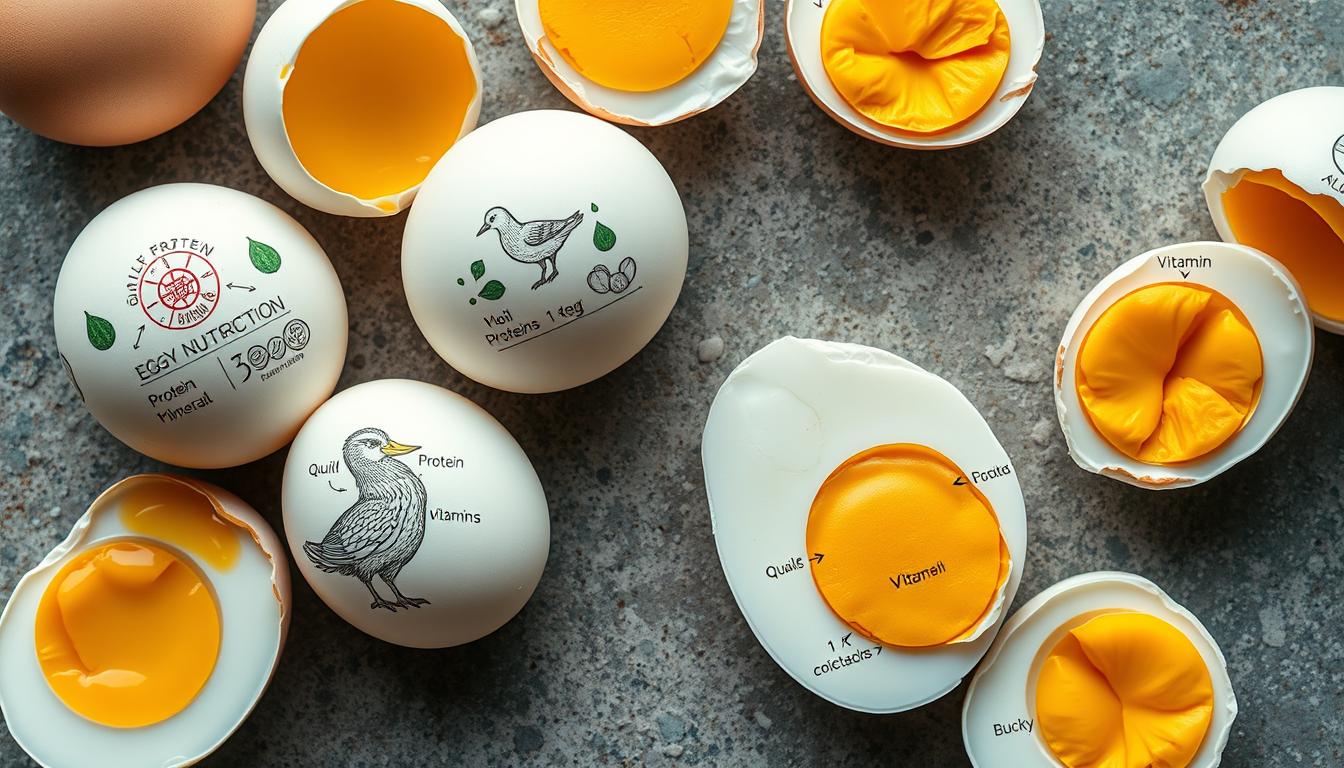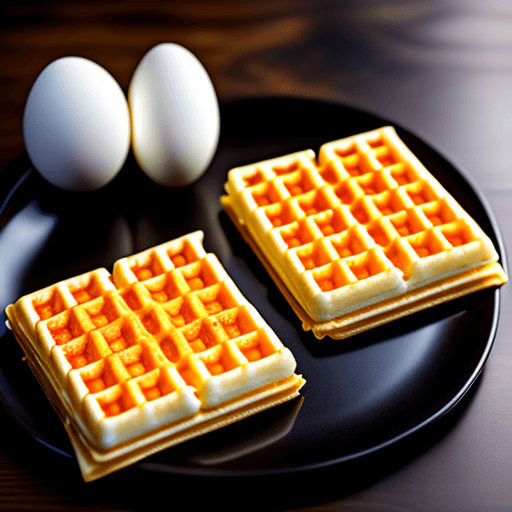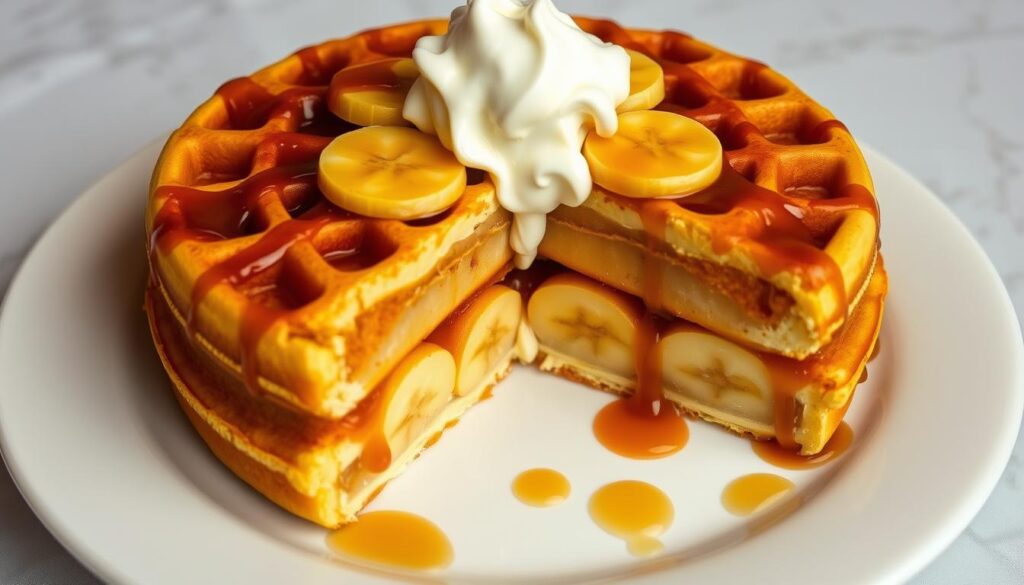Did you know over 1000 banana varieties grow worldwide? They are divided into 50 groups. Bananas are fascinating, with a rich history and surprising properties. Every year, more than 100 billion bananas are eaten globally, making them the fourth most popular food.
Bananas are common in stores and kitchens, but they’re more than just a snack. The Cavendish banana, the most exported, faces a crisis due to Panama Disease. This disease is similar to what wiped out the Gros Michel in the 1960s.
Bananas are not just tasty; they’re also versatile in cooking and natural remedies. Banana peels can heal splinters, soothe insect bites, and even polish leather. They’re also packed with potassium, which can help lower the risk of stroke and heart attack.
In the U.S., people eat an average of 27 pounds of bananas each year. Over 96% of American households buy bananas monthly. But in Uganda, residents eat the most bananas, with an average of 1⅓ lb (605 g) per person daily.
Key Takeaways
- Over 1000 banana varieties exist worldwide, with the Cavendish being the most exported.
- Bananas face threats from diseases like Panama Disease, which previously wiped out the Gros Michel variety.
- Banana peels have surprising uses, such as healing splinters and polishing leather.
- Bananas are rich in potassium, which may lower the risk of stroke and heart attack.
- Uganda has the highest per capita consumption of bananas, while Americans eat an average of 27 pounds per person annually.
Table of Contents
- 1 Bananas are Slightly Radioactive
- 2 The Banana Is Actually a Berry
- 3 The Banana Plant Is an Herb, Not a Tree
- 4 You Can Eat Banana Flowers
- 5 Bananas Come in a Rainbow of Colors
- 6 Banana Fibers Can Be Used for Weaving
- 7 The Banana “Trunk” Is Edible
- 8 Green Bananas Are a Versatile Staple Food
- 9 Banana Peels Can Soothe Insect Bites, Splinters, and Itching
- 10 Overripe Bananas Can Be Fermented into Wine or Vinegar
- 11 The World’s Most Expensive Banana Costs $120,000
- 12 Bananas Have a Dark History of Political Turmoil
- 13 The Gros Michel Banana Was Wiped Out by Disease
- 14 Some Believe the Forbidden Fruit in Eden Was a Banana
- 15 Bananas Are a Controversial “Health Food”
- 16 Source Links
Bananas are Slightly Radioactive
Did you know bananas, a favorite snack worldwide, are slightly radioactive? This is because they contain potassium-40, a naturally occurring isotope. Potassium-40 makes up only 0.012% of potassium atoms, with a half-life of 1.3 billion years.
Because of potassium-40, bananas are a bit radioactive. In fact, a truckload of bananas can trick radiation detectors meant for nuclear weapons.
The radioactive element in bananas is potassium-40
Potassium-40 is found in many foods, including bananas. A banana has about 450 mg of potassium, which means it exposes us to about 0.01 mrem of radiation. While bananas are high in potassium, they’re not the top source.
Banana Equivalent Dose
The Banana Equivalent Dose (BED) measures radiation exposure from bananas. For example, a chest x-ray gives 10 mrem of radiation, much more than a banana.
| Radiation Source | Exposure (mrem) | Banana Equivalent Dose (BED) |
|---|---|---|
| Eating a banana | 0.01 | 1 |
| Chest x-ray | 10 | 1,000 |
| Sleeping next to someone | 0.05 | 5 |
How many bananas do you have to eat before experiencing radiation poisoning?
Eating a lot of bananas is needed to get significant radiation exposure. You’d need to eat at least a thousand bananas to get 10 mrem, which slightly increases death risk. To get a lethal dose, you’d have to eat millions of bananas at once. In fact, a billion bananas would be needed for lethal exposure.
Our bodies naturally have about 120 grams of potassium, keeping a steady level through diet and excretion. This prevents the buildup of radioactive potassium. Humans are 280 times more radioactive than bananas due to stored K-40. The radioactivity in bananas is very small, much less than the natural radiation we get daily.
So, bananas are slightly radioactive, but the levels are so low they don’t pose a health risk. Sleeping next to someone actually exposes you to more radioactivity than bananas because of C-14 in exhaled carbon dioxide. Our bodies can handle small amounts of radiation, and daily exposure is safe.
The Banana Is Actually a Berry
Bananas often confuse people when it comes to fruit classification. They look different from other fruits, but they are actually berries. This is because they grow from a flower with one ovary. Bananas have a soft skin and a fleshy middle, fitting the berry definition.
Botanical Classification of Bananas
Berries have three layers: the outer skin, the fleshy middle, and the innermost part with seeds. Bananas, along with grapes and oranges, are scientifically berries. They don’t have seeds because they are grown for food.
Bananas grow in clusters on a plant called a bunch. Each bunch can have 7 to 14 hands of bananas. In warm places, bananas grow all year.
Differences Between Berries and Other Fruits
Some fruits, like blueberries, are true berries because they grow from flowers with one ovary. Oranges are a special type of berry called hesperidium. Cherries are not berries because they have only one seed. Strawberries and raspberries are made of many parts from one flower.
| Fruit | Botanical Classification |
|---|---|
| Banana | Berry |
| Blueberry | Berry |
| Tomato | Berry |
| Orange | Hesperidium (subtype of berry) |
| Cherry | Drupe |
| Strawberry | Aggregate fruit |
For centuries, scientists have tried to sort fruits into groups. But it’s hard because nature is so complex.
The Banana Plant Is an Herb, Not a Tree
Despite looking like trees, banana plants are actually herbs. They are more like ginger and turmeric than true trees. In systematic botany and taxonomy, they are classified as herbs. This is because of their unique anatomy and growth habits, which are different from trees.
Anatomy of a Banana Plant
The banana plant’s “trunk” is actually a pseudostem. It’s made of tightly packed leaf sheaths. Unlike tree stems, it doesn’t have cellulose, hemicellulose, or lignin, key parts of woody tissue.
Banana plants have a special structure called a corm. This is where the pseudostem and leaves come from. They don’t have a typical root system like trees do.
Banana plants can’t store carbon long-term like trees can. This is why they are not considered trees but herbs.
Comparison to Other Herbaceous Plants
Banana plants live shorter lives than trees. They usually die after they produce fruit. Trees, on the other hand, can live for many years or even centuries.
Banana plants can’t grow like trees do. They don’t have a cambium layer, which is needed for growth.
Despite being herbs, banana plants are very important. They feed over 400 million people worldwide. With over 1,000 varieties grown in 135 countries, they are key in global agriculture and economics.
You Can Eat Banana Flowers
Did you know the large, purple flower at a banana bunch’s end is edible? These beautiful blooms, known as banana flowers or banana blossoms, are a delicacy in many parts of the world. They are a big part of Southeast Asian cuisine.
Banana flowers are used in cooking, adding a unique flavor and texture to dishes. In countries like Thailand, Indonesia, and the Philippines, they are often used in soups, stews, and curries. The petals and the innermost bracts are the most tender and flavorful, making them the best choice for cooking.
To prepare banana flowers for cooking, the tough outer layers are removed. This reveals the softer, more delicate inner petals. These petals are then sliced or chopped and added to various recipes. Banana flowers have a slightly bitter taste and a crunchy texture, adding an interesting dimension to dishes.
Banana flowers are also known for their nutritional value. They are rich in vitamins A and C, as well as minerals like potassium and calcium. Adding these edible flowers to your diet can boost your immune system and promote healthy digestion.
Each banana plant produces only one bunch per year, with up to 200 bananas in double row clusters. Bananas are considered mature 3 to 6 months after the bell has flowered. During this time, the banana flowers can be harvested and used in various culinary applications.
So, the next time you see a banana flower, don’t hesitate to try it in your cooking. Using this unique ingredient can add an exciting twist to your meals. It introduces you to new flavors from different parts of the world.
Bananas Come in a Rainbow of Colors
Bananas are not just yellow. They come in many colors like red, purple, and even tie-dye. Over 100 billion bananas are eaten every year worldwide. Yet, many people don’t know about all the different kinds.
Red bananas are special. They taste sweet and creamy. They are smaller than usual and turn reddish-purple when ripe. They also have lots of potassium and vitamin C.
The colors of bananas come from different pigments in their peels. Humans can see over a million colors. Bananas show a wide range of colors, like the Blue Java’s deep blue and the Musa Ae Ae’s marbled look.
The color of a banana can tell you if it’s ripe. As bananas ripen, their peels change color. This is why yellow bananas are usually ripe. But, some bananas, like the Red Dacca, stay red even when ripe.
| Banana Variety | Color | Flavor Profile |
|---|---|---|
| Cavendish | Yellow | Sweet, creamy |
| Red Banana | Reddish-purple | Sweet, creamy, slightly raspberry-like |
| Musa Ae Ae | Marbled yellow and white | Starchy, mild flavor |
| Blue Java | Silvery-blue | Creamy, ice cream-like flavor |
Exploring banana colors and varieties is fun and educational. From yellow Cavendish to red and purple bananas, each has its own taste and health benefits. By trying different bananas, we can discover new flavors and learn about this fruit’s long history, dating back thousands of years.
Banana Fibers Can Be Used for Weaving
Banana fibers come from banana plant stalks and have been used for centuries. They are turned into banana silk, used for traditional clothes and ceremonial outfits. In Japan and Southeast Asia, artisans make mats, thongs, baskets, and lashings from these fibers.
India produces the most bananas, about 28.4 million tonnes every year. This makes India the biggest producer of banana fabric, beating the Philippines. Most banana fiber comes from the Philippines, with some also coming from Ecuador, Malaysia, Indonesia, Costa Rica, Bangladesh, and India.
Banana fiber production is an eco-friendly option and helps banana farmers earn extra money. The fibers come from banana tree stems, which are often thrown away after fruit picking. This waste is over a billion tons each year. Using these fibers reduces the environmental impact of banana farming.
The quality of banana fiber depends on the stem part used, leading to different weights and thicknesses. There are two types: inner-peel and outer-peel. Inner-peel is softer and more expensive, while outer-peel is coarser and cheaper.
| Fiber Type | Characteristics | Uses |
|---|---|---|
| Inner-peel | Soft, silk-like, expensive | High-end textiles, clothing |
| Outer-peel | Coarse, strong, affordable | Ropes, mats, baskets, paper |
Companies like Valani use banana fiber in their sustainable clothes. They operate a GOTS 6.0 certified facility in India, showing the material’s promise. As the industry grows, more certifications might come to ensure it’s safe and sustainable.
From traditional crafts to modern eco-fashion, banana weaving and textiles show the amazing versatility and value of this natural fiber.
The Banana “Trunk” Is Edible
Did you know the inner core of a banana plant’s pseudostem is edible and nutritious? Bananas come from Southeast Asia and are now found in places like Florida. The banana plant is actually an herb, growing up to 7 meters tall.
Traditional Uses in Southeast Asian Cuisine
In Southeast Asia, like Burma (Myanmar), the banana plant’s core is a vegetable. It’s sliced thin and eaten raw, boiled, or in soups like mohinga. This adds a special touch to traditional dishes.
Nutritional Benefits of Banana “Trunks”
The banana stem is not just tasty but also full of nutrients. It’s rich in dietary fiber, which helps digestion. It also has potassium and vitamin B6, making it great for your diet. Bananas are as nutritious as potatoes, making them a great food choice.
The Cavendish banana is popular for its taste and nutritional value. But, exploring the banana plant’s other parts can add variety to your meals. By using the banana trunk in cooking, you can enjoy new flavors and health benefits. Next time you make a banana-based treat, think about the plant’s other uses!
Green Bananas Are a Versatile Staple Food
Green bananas are a staple in many tropical cuisines. Unlike ripe bananas, they are used like a starchy vegetable. You can boil them whole, slice and fry, mash into dumplings, or dry and grind into flour.
Green bananas have a unique nutritional profile. They are rich in resistant starch, which feeds good gut bacteria. This starch also helps control blood sugar after meals. They also provide vitamins and minerals like vitamin C, potassium, and magnesium.
Adding green bananas to your diet is easy and healthy. They are low in calories, with one medium banana having about 100 calories. They also have 3 grams of fiber per medium banana. This fiber, along with resistant starch, helps regulate blood sugar and control hunger.
Green bananas offer more than just digestive health benefits. They are good for heart health, thanks to potassium. Eating bananas may also lower heart attack and stroke risks and reduce cancer risk. Their antioxidants help fight heart disease and macular degeneration.
| Nutrient | Amount per Medium Green Banana | % Daily Value |
|---|---|---|
| Calories | 112 | – |
| Fat | 0 g | 0% |
| Protein | 1 g | 2% |
| Carbohydrates | 29 g | 10% |
| Fiber | 3 g | 12% |
| Vitamin C | 12% DV | 12% |
| Potassium | 10% DV | 10% |
| Magnesium | 8% DV | 8% |
Cooking with green bananas opens up endless possibilities. They can be used in savory dishes or baked goods. This versatile ingredient adds new flavors and textures to your meals, while providing health benefits.
Banana Peels Can Soothe Insect Bites, Splinters, and Itching
Banana peels are great for soothing insect bites, splinters, and itching. They are packed with bioactive compounds like carotenoids and polyphenols. These compounds give banana peels strong antimicrobial and antioxidant properties, helping to ease skin irritations.
Natural Remedies Using Banana Peels
One of the top uses for banana peels is treating insect bites and rashes. Rubbing the inside of a banana peel on itchy skin can help. It works because of the natural antihistamines in the peel.
They can also help remove splinters. Just hold a piece of peel on the area for 5 to 10 minutes. The enzymes in the peel can help pull out the splinter, making it less painful.
Scientific Explanation for Banana Peel’s Soothing Properties
A 2012 study showed that banana peels have anti-inflammatory compounds. They also fight bacteria that cause gum disease.
Banana peels are full of amino acids, vitamins A, B, C, and E, which are good for the skin. They have a lot of potassium, which helps with itching and swelling from bites.
| Banana Peel Benefit | Active Compounds | Effect |
|---|---|---|
| Soothing insect bites and rashes | Natural antihistamines, potassium | Relieves itching and swelling |
| Removing splinters | Enzymes | Aids in ejecting wood from skin |
| Anti-inflammatory properties | Polyphenols, carotenoids | Reduces inflammation |
Many people swear by banana peels for different uses, but not all claims are backed by science. Yet, studies do show they can help with skin issues and improve skin health.
Looking for a tasty treat to go with your banana peel remedy? Try making some delicious waffle recipes with almond milk. These waffles are a nutritious and tasty breakfast that pairs well with the benefits of banana peels.
Overripe Bananas Can Be Fermented into Wine or Vinegar
Bananas are a favorite fruit worldwide, thanks to the U.S. Department of Agriculture. In America, bananas are seen as a top healthy snack. But did you know you can make wine or vinegar from overripe bananas?
As bananas ripen, they turn from starch to sugar. This change feeds yeast, leading to banana wine or beer. India, the biggest banana producer, likely has a big banana wine market.
By adding acetic acid bacteria, you can make banana vinegar. The vinegar market is huge, with the European Union making a lot of money from it in 2018. Banana peel vinegar is special and might be good for your health.
A study looked at banana peel vinegar and compared it to other vinegars. They checked its taste, health benefits, and more. The results were interesting.
In Veracruz, Mexico, they make a banana vinegar that’s sweet and funky. It’s got a unique taste and is made from overripe bananas.
Bananas and their products might be good for you. Eating bananas can lower your risk of kidney cancer. As research grows, using overripe bananas for wine and vinegar might become more popular.
The World’s Most Expensive Banana Costs $120,000
In the world of art banana installations, Italian artist Maurizio Cattelan’s “Comedian” made headlines. It was sold at the Art Basel Miami Beach fair for between US$120,000 and US$150,000. The piece, a real Cavendish banana duct-taped to a wall, is now valued at US$1 million to US$1.5 million at a Sotheby’s auction.
For comparison, Claude Monet’s “Water Lilies” paintings are expected to sell for around $60 million at the same auction. This shows a big difference in value between traditional art and Cattelan’s banana art installation. David Datuna, an artist, criticized the piece for its focus on wealth and food security.
Considering the average price of bananas in Canada is about $1.50 per kilogram, 600,000 bananas could be bought for the price of the art.
“Comedian” is part of a series of three fruits, meant to be replaced regularly. The bananas and duct tape are key to the artwork. The original banana in Miami is gone, replaced by a certificate of authenticity for buyers.
This expensive bananas artwork is a mix of humor, provocation, and historical reflection. It challenges traditional art norms, as Cattelan often does. David Galperin, Sotheby’s head of contemporary art, says it comments on art valuation and what makes an artwork.
Read more about the GreenPan Elite 4 Square Belgian Classic Waffle Maker here.
Bananas Have a Dark History of Political Turmoil
Bananas are loved by many around the world. But, the banana industry history is filled with exploitation and political trouble. The term “banana republics” was used to describe Latin American countries controlled by the banana trade in the early 20th century.
The United Fruit Company started in 1899 and had huge banana plantations in Latin America. It had a lot of political power. The company even helped start a coup in Guatemala in 1954. This was because President Arbenz wanted to limit its power, leading to thirty years of military rule and war that killed 200,000 civilians.
The United Fruit Company Scandal
In 1975, the United Fruit Company was caught bribing Honduras’ president for better export taxes. This led to the president’s death. It showed how deep the corruption was and how much control the company had over banana-producing countries.
Impact on Banana-Producing Countries
Bananas being a main export crop made countries unstable and unequal. In 1928, the United Fruit Company was involved in the Ciénaga massacre in Colombia. Over 1,000 striking workers were killed by the military. The strike was about bad working conditions and low pay.
Today, the banana industry is not free from exploitation. The International Labour Organization says at least 20.9 million people were forced to work in 2012. Most of them were in private businesses. The banana industry, like other farming, makes money by using forced labor.
As consumers, we need to think about the ethics of our food choices. Supporting fair trade and sustainable farming can help change the banana industry’s dark past. It’s a step towards a fairer future for everyone involved in bananas.
The Gros Michel Banana Was Wiped Out by Disease
There are over 1,000 banana types worldwide, each with its own taste and texture. The Gros Michel banana was a favorite in the U.S. from the 1870s until the mid-1950s. It was loved for its sweet taste, creamy feel, and enticing smell.
But, the Gros Michel’s reign ended with Panama disease in the 1950s. This fungal disease, caused by Fusarium wilt, destroyed Gros Michel crops. Farmers then turned to the Cavendish variety, which was more resistant to the disease.
The Cavendish banana now rules the U.S. market, with Americans eating about 100 Cavendish bananas each year. The Gros Michel, once common, is now rare and hard to find. Experts say the Gros Michel is sweeter, more fragrant, and has a firmer texture than the Cavendish.
| Characteristic | Gros Michel | Cavendish |
|---|---|---|
| Flavor | Sweeter, more fragrant | Less sweet, mild flavor |
| Texture | Firmer, creamier | Softer, less firm |
| Cooking Performance | Retains firmness when cooked | Softens more quickly when cooked |
The Cavendish banana is now facing a new threat from Tropical Race 4 (TR4) of Fusarium wilt, found in the Americas in 2019. There’s no known cure for TR4. The banana industry is fighting against disease, climate change, and environmental issues. Sustainable farming and developing disease-resistant bananas are key to the fruit’s future.
Some Believe the Forbidden Fruit in Eden Was a Banana
The Garden of Eden is a key part of the Book of Genesis. It’s where Adam and Eve ate the forbidden fruit. But, the Bible doesn’t say what fruit it was from the tree of knowledge. Many think it was an apple, but that’s not confirmed.
Historical and Religious Theories
Many have guessed what the forbidden fruit could be. Ideas include wheat, figs, grapes, etrog, and bananas. Some old texts suggest bananas, calling them the “apple of Eden”.
In Western culture, apples are often seen as the forbidden fruit. But, early Jewish texts don’t mention apples.
The Garden of Eden might have been in modern-day Iraq. This means the fruit could have been a pomegranate or something native there. Some even thought of the sabra (prickly pear) because it grows fast in that area.
Botanical Evidence Supporting the Banana Theory
The banana’s Latin name, Musa sapientum, means “muse of the wise person”. This has led some to think bananas might be the forbidden fruit. Bananas are full of natural sugars and nutrients like potassium and iron.
Bananas were rare in the U.S. until 1885. The Boston Fruit Company started bringing them in then. Refrigeration made it easier to ship bananas worldwide.
While we can’t know for sure what the forbidden fruit was, talking about it is interesting. It helps us understand the Bible better and correct common mistakes.
Bananas are good for athletes and people watching their diet. They’re full of energy and have no fat or cholesterol. A medium banana has little fat and can help lower blood cholesterol because of its pectin. You can learn more about their benefits here.
Bananas Are a Controversial “Health Food”
Bananas are a favorite fruit in America, eaten more than apples and oranges. They are packed with fiber, potassium, magnesium, and Vitamin B6. Plus, they have only 105 calories, 0.5g of fat, and 1mg of sodium. The American Heart Association says we should eat 4 servings of fruit daily, and bananas can help with that.
But, bananas have a lot of quick-digesting carbs and sugars. One banana has 17 grams of sugar and 24 grams of carbs, which can raise blood sugar. Their glycemic index is 55, which is moderate but lower than watermelon’s GI of 76.
Some experts say to eat bananas in moderation for weight and blood sugar control. Bananas are a good source of fiber, which is rare in the American diet. But, people with kidney problems should watch their potassium intake because bananas are high in it. Those allergic to bananas should be careful.
In summary, bananas have good nutrition facts and can fit into a healthy diet. But, it’s important to think about your own health needs. Talking to a healthcare professional can help decide if bananas are right for you. Knowing the good and bad about bananas can help you make better choices for your diet.
Source Links
- 30 Facts About Bananas That Will Make You Go Bananas – The Fact Site – https://www.thefactsite.com/banana-facts/
- Fun banana facts | The Banana Police – https://thebananapolice.com/fun-facts/
- Benefits of Bananas: 11 Things You Probably Didn’t Know | Chiquita – https://www.chiquita.com/blog/11-things-you-probably-didnt-know-about-bananas/
- Is it true that bananas are radioactive? – https://www.mcgill.ca/oss/article/you-asked/it-true-banana-radioactive
- Bananas are slightly radioactive. – https://interestingfacts.com/fact/bananas-are-slightly-radioactive/
- Are bananas really ‘radioactive’? An expert clears up common misunderstandings about radiation – https://theconversation.com/are-bananas-really-radioactive-an-expert-clears-up-common-misunderstandings-about-radiation-193211
- Why are bananas berries but strawberries aren’t? – https://www.livescience.com/57477-why-are-bananas-considered-berries.html
- Is a Banana a Berry or Fruit? The Surprising Truth – https://www.healthline.com/nutrition/bananas-berries-or-fruits
- Why a Banana Plant is Actually an Herb AND a Berry – https://gardenbetty.com/a-banana-plant-is-an-herb-or-little-known-banana-facts/
- Why Is A Banana Tree Not Really A Tree? – https://www.scienceabc.com/pure-sciences/why-is-a-banana-tree-not-really-a-tree.html
- Plant science at the dinner table: bananas – https://www.canr.msu.edu/news/plant-science-at-the-dinner-table-bananas
- Did You Know Bananas… – The Root Cause – https://therootcause.com.au/did-you-know-bananas/
- 10 Shocking Banana Facts and the Grim Future of Your Favorite Fruit – https://waltersdiary.medium.com/10-shocking-banana-facts-and-the-grim-future-of-your-favorite-fruit-72b1ac7599b6
- Be Smart | What Color Is A Banana? | Season 7 | Episode 23 – https://www.pbs.org/video/what-color-is-a-banana-sbsjyn/
- 10 Things You Didn’t Know About the Banana Rancho Mastatal – https://ranchomastatal.com/blognewsletter/2020/4/8/10-things-you-didnt-know-about-the-banana
- What is Banana Fabric: Properties, How its Made and Where – https://sewport.com/fabrics-directory/banana-fabric
- Banana Fiber: Transforming Banana Tree Waste Into Fabric | Made Trade – https://www.madetrade.com/blogs/magazine/banana-fabric?srsltid=AfmBOooZdcNuobT3mCN-U1lTUDuNkwYvyQioTYYVSjgKP2zWr8IK-bY3
- Bananas: More Than A Yellow Frou Frou Fruit – Eat The Weeds and other things, too – https://www.eattheweeds.com/bananas-more-than-a-yellow-fru-fru-fruit/
- Banana – https://en.wikipedia.org/wiki/Banana
- Bananas: 11 Evidence-Based Health Benefits – https://www.healthline.com/nutrition/11-proven-benefits-of-bananas
- 8 things you didn’t know about bananas – https://www.pbs.org/newshour/nation/8-things-you-didnt-know-about-bananas
- 23 Banana Peel Uses: For Skin Care, Hair Health, First Aid, and More – https://www.healthline.com/health/banana-peel-uses
- Save your old banana peels to treat these pesky skin issues naturally – https://www.yahoo.com/lifestyle/save-old-banana-peels-treat-212812199.html
- Weird but helpful ways bananas and their peels can be used – https://nypost.com/2023/11/06/lifestyle/weird-but-helpful-ways-bananas-and-their-peels-can-be-used/
- Fermented Bananas: A DIY Probiotic Delicacy – https://www.drlamcoaching.com/blog/fermented-bananas-a-diy-probiotic-delicacy/
- Physicochemical Characteristics of Vinegar from Banana Peels and Commercial Vinegars before and after In Vitro Digestion – https://www.mdpi.com/2227-9717/9/7/1193
- Banana Vinegar – https://www.ranchogordo.com/products/banana-vinegar
- Ingredients: Banana, duct tape, wall. Prep time: Seconds. Cost: US$1 million – https://www.ctvnews.ca/mobile/world/how-a-viral-duct-taped-banana-came-to-be-worth-us-1-million-1.7113252
- Someone Ate The $120,000 Duct Tape Banana, Again – https://www.forbes.com/sites/danidiplacido/2023/05/01/someone-ate-the-120000-duct-tape-banana-again/
- Why a banana duct-taped to a wall sold for $120,000 – https://www.ctvnews.ca/lifestyle/why-a-banana-duct-taped-to-a-wall-sold-for-120-000-1.4719724
- The Dark Side of Bananas: Imperialism, Non-State Actors, and Power – https://hir.harvard.edu/the-dark-side-of-bananas-imperialism-non-state-actors-and-power/
- Banana Massacre – https://en.wikipedia.org/wiki/Banana_Massacre
- PDF – https://philarchive.org/archive/RIZTPO-3
- Peeling Back the History of Bananas – https://us.kadalys.com/blogs/the-banana-blog/history-of-bananas
- Bananas Don’t Taste Like They Used To. Here’s Why – https://www.epicurious.com/ingredients/history-of-the-gros-michel-banana
- What Kind of Fruit Did Adam and Eve Eat? | Jesse Joyner, PhD – https://jessejoyner.com/what-kind-of-fruit-did-adam-and-eve-eat/
- What’s the Truth About. . . The Apple in the Garden of Eden? – Jewish Action – https://jewishaction.com/religion/jewish-law/whats-truth-apple-garden-eden/
- Bananas: The Forbidden Fruit – Center for Nutrition Studies – https://nutritionstudies.org/bananas-the-forbidden-fruit/
- < Bananas: The Uncertain Future Of A Favorite Fruit – https://www.npr.org/transcripts/139787380?ft=nprml&f=139787380
- Here’s What Happens to Your Body When You Eat Bananas Every Day – https://www.yahoo.com/lifestyle/happen-body-eat-bananas-every-214500457.html
- Busting Banana Myths—Health Food or Not – https://www.yourtotalhealthexperience.com/busting-banana-myths-health-food-or-not/
